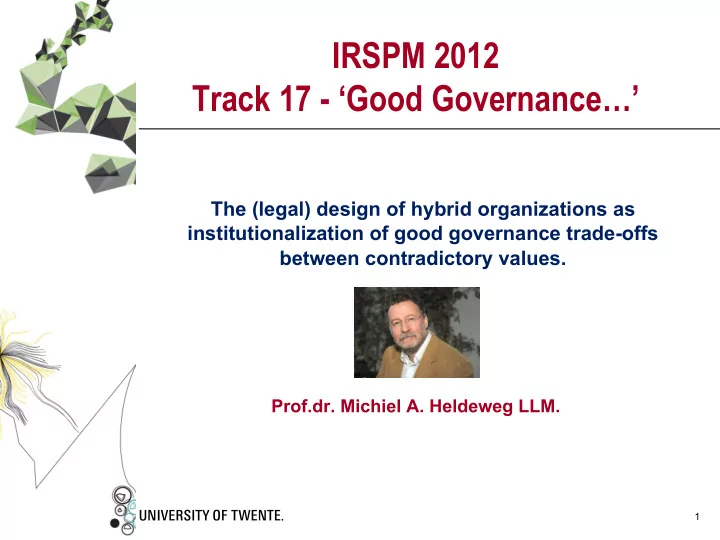

IRSPM 2012 Track 17 - ‘Good Governance…’ The (legal) design of hybrid organizations as institutionalization of good governance trade-offs between contradictory values. Prof.dr. Michiel A. Heldeweg LLM. 1
HYBRID ORGANIZATIONS CONTRADICT. PUB.VALUES Track 17 “Good Governance in terms of Properly Managing Contradictory Public Values” GG-PM-CPV 2
HYBRID ORGANIZATIONS CONTRADICT. PUB.VALUES Roadmap 1. Some basics 2. Types of interests and values 3. Institutional Environments 4. Legal Design Methodology – regarding norms 5. Better & Smart Regulation 6. Some conclusions 3
GG-PM-CPV SOME BASICS Perspective: legal-administrative design methodology Object: Public Service Organization (PSO) Consider PSO in context: alignment CPV as a matter of hybridity of organizations Values x Interests: values normative criteria/guidelines to choice or evaluation of actions concerning interests 4
TYPES OF VALUES & INTERESTS Interest scope Personal/Particular ó ó Societal (society as a whole) Sec or also Public (government) - general (societal fabric) - specific (alloc. of services) Value scope Follows scope of interest Public or private interests - values - private: personal + societal sec - public: public sec 5
GG-PM-CPV INSTITUTIONAL ENVIRONMENT S ocial interaction pattern + value-interest combination - Structures, mechanisms, processes Institutional sphere of social action; operating as if ‘real’; e.g. ‘the market’ - As modes of governance: actor influence & allocation achievement 6
GG-PM-CPV INSTITUTIONAL ENVIRONMENT Hierarchy – publ. office; unilateral; publ interest/values Network – societal org; cooperation; soc’tal interest/values Market – firms; compet. bargaining; trade interest/values Ideal type – in reality intertwined and overlapping 7
GG-PM-CPV INSTITUTIONAL ENVIRONMENT Societal acceptance of institutional environments (IE’s) Each IE = unique type of societal value configuration acceptance concerns legitimacy, justice, effectiveness and efficiency of an IE as a value configuration related to particular service allocation With 3 IE’s no contradictions between value configurations only between individual values 8
DIMENSIONS OF SOCIETAL VALUE CONFIGURATIONS (AS IN IE) Legitimacy – id quod - ‘What can legally be done by who?’ Legal validity – modus quo - ‘How may/shall or can something legally be done?’ Effectiveness – achieving objectives - ‘What can practically be done?’ Efficient – most effective or least of means - ‘How can something be done?’ 9
GG-PM-CPV ACKNOWLEDGEMENT: ALIGNMENT Organizations (e.g. PSOs): institutional social practices with element of normativity - employer-employee; management-operations Interactions with other organizations require acknowledgement of organizations (and their actions): as players – value alignment Society : Institutional Environments : Organizations - societal acceptance - - alignment - 10
GG-PM-CPV ORGANIZATIONS: ALIGNMENT Basic organization characteristics: ideal type Personality – cap’ty to act; 3 legal conditions; prelim.* Mission – publ.task – private profit – community service Control – publ.auth. – investors+ - professionals Response – publ.good – competition – members resp. *Types of legal persons: associations – corporations – foundations: multi-applicable 11
GG-PM-CPV ORGANIZATIONS: ALIGNMENT Ideal type alignment Organization – IE - friction free on Legitimacy-Justice-Effectiveness-Efficiency Hierarchy Network Market Personality diverse diverse Esp corp. Mission Publ.task CommServ Priv.profit Control Publ.auth. Profession. Investors+ Response Publ.good Mem’rresp. Competit. Alignment L-J-E-E (1) L-J-E-E (2) L-J-E-E (3) Possibility of plural alignment – versatility in legal personality; non-contradictory and shared values in IEs 12
CONTRADICTORINESS STRUCTURE: NORMS) Ideal types combine different values – configurations alone do not contradict Envir 1 Envir 2 Envir 3 Value A + - o Value B + - o Value C + + + Value D - + - 1+2 contradict on A+B, 2+3 on D; C is shared by all 1-3 At best partial contradictions … .. 13
HYBRID ORGANIZATIONS A departure from ideal type alignment in two types: Singular (‘1 characteristic’) (partial multiple) Ambivalence in Mission or Control or Response Across H-N-M: 9 (double) + 9 (triple) = 18 hybrids* Multiple (‘2 or 3 characteristics’) Ambivalence between Mission and/or Control and/or Response Across H-N-M: 21 (double) + 6 (triple) = 27 hybrids* * 4 categories: 1. H-M; 2. M-N; 3. N-H; 4. All 14
GG & PM Governance: setting of rules of the game - behavior patterns – empirically - rules to be adhered to – normativity Management: setting a game plan within the rules of the game - selecting best action possibilities - structuring relations and processes Gov’ce and man’t apply to both environments & organizations Besides players – principal parties (e.g. found.fathers; CEO’s) 15
GG-PM-CPV 1 No contradictory values within ideal type environments, nor within ideal type organizations, nor between environments and their ideal type organizations At most contradictions possible between individual values across environments and organizations In ideal type setting no challenge of GG-PM other than safeguarding setting 16
GG-PM-CPV 2 What remains: hybridity – anomaly poses value clash between hybrid organization and ideal type environment Anomalies are possible challenge to alignment (if contradictory) with environment and to societal acceptance of environment Alignment and acceptance can be resolved in creation of hybrid environments – shifts in L-J-E-E; contradictory values; involving trade offs (e.g. unilateral=>contractual: voice=>exit) 17
HIERARCY HYBRIDS: EXAMPLES Examples of shifts towards hybrid environments Concerning public values - Hierarchy hybrids Liberalization to regulated markets (H-N: 9) - competition but regulated allocation Autonomization to regulated social enterprises (H-M: 9) - bestowment of public authority Public-Private-Partnerships (H-M-N: 6+1) - e.g. certification (3 rd party regulation); - theoretically (1) ‘superhybrid singularity’? 18
HIERARCY HYBRIDS: CONTRADICTORY PUBLIC VALUES? Hierarchical-Hybrid environment: also + fully public interest + accompanying public values Alien interests & values must be commensurable: public! Not only when public authority No go areas: cartel-analogy (compete&cooperate) Sui generis regimes of administrative law Fragmentation = Challenge to societal acceptance Beware of free radicals! 19
ISSUE OF CONTRADICTORY PUBLIC VALUES Issue of safeguarding related to ideal type hierarchy – government relationship Issue of feasibility of hybrid environments accommodating hierarchical-hybrid organizations (such as PSO’s) Issue of control over free radicals Challenge of Good Governance & Proper Management 20
Recommend
More recommend